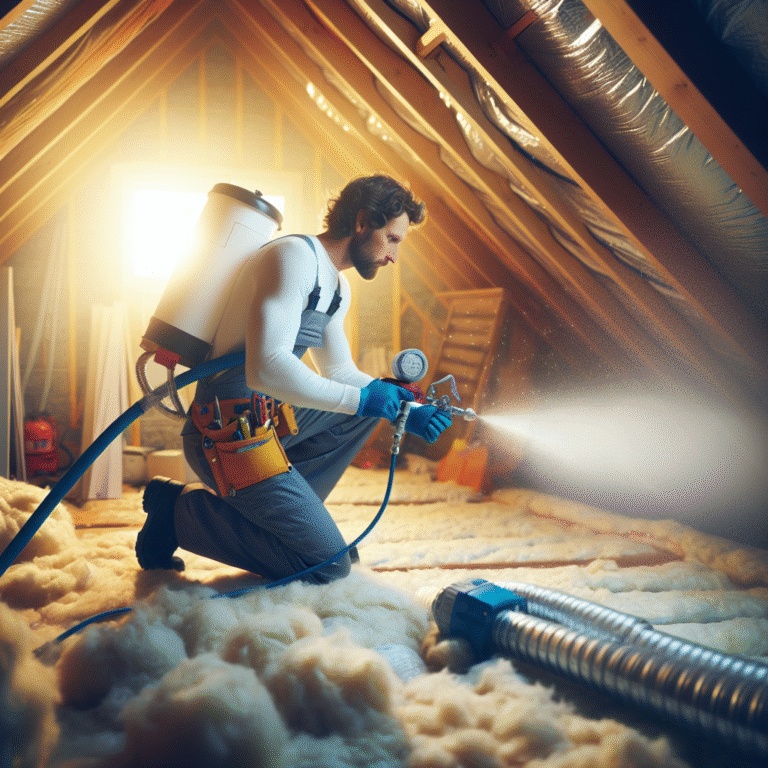-
Table of Contents
Go green and stay cozy with our eco-friendly insulation solutions for a sustainable home.
“Join the movement towards sustainable living by choosing eco-friendly insulation options for your home. Visit texasinsulationsolution.com to learn more and make a positive impact on the environment today.”
Introduction
Eco-friendly insulation options are becoming increasingly popular as people strive to live more sustainably and reduce their environmental impact. Insulation is an important aspect of sustainable living, as it helps to reduce energy consumption and greenhouse gas emissions. In this introduction, we will explore some of the top eco-friendly insulation options available and how they can contribute to a more sustainable lifestyle. By choosing these options, not only can we reduce our carbon footprint, but also create a healthier and more energy-efficient living space.
Benefits of Using Eco-Friendly Insulation for Energy Efficiency in Homes
In today’s world, there is a growing concern for the environment and the impact of human activities on it. As a result, more and more people are looking for ways to live a sustainable lifestyle. One aspect of sustainable living is reducing energy consumption in our homes. This not only helps the environment but also saves money on energy bills. One way to achieve this is by using eco-friendly insulation in our homes.
Eco-friendly insulation is made from natural and renewable materials, such as recycled paper, cotton, wool, and even mushrooms. These materials are non-toxic, biodegradable, and have a low carbon footprint, making them a great choice for those looking to reduce their environmental impact.
One of the main benefits of using eco-friendly insulation is its energy efficiency. Traditional insulation materials, such as fiberglass and foam, may be effective in keeping the heat in during the winter and out during the summer, but they also have a negative impact on the environment. These materials are made from non-renewable resources and can release harmful chemicals into the air. On the other hand, eco-friendly insulation is made from natural materials that are sustainable and do not harm the environment.
Moreover, eco-friendly insulation has a higher R-value, which is a measure of how well a material resists heat flow. This means that it is more effective in keeping the heat in during the winter and out during the summer, reducing the need for heating and cooling systems. As a result, homeowners can save money on their energy bills while also reducing their carbon footprint.
Another benefit of using eco-friendly insulation is its ability to improve indoor air quality. Traditional insulation materials can release harmful chemicals into the air, which can cause health problems such as respiratory issues and allergies. Eco-friendly insulation, on the other hand, is made from natural materials that do not emit any harmful chemicals. This creates a healthier living environment for homeowners and their families.
Furthermore, eco-friendly insulation is also known for its soundproofing capabilities. The natural fibers in these materials absorb sound waves, reducing noise pollution in the home. This is especially beneficial for those living in noisy areas or for homeowners who want to create a peaceful and quiet living space.
In addition to its environmental and health benefits, eco-friendly insulation is also easy to install. It can be blown, sprayed, or rolled into place, making it a versatile option for different types of homes and structures. This also means that it can be installed without the need for professional help, saving homeowners money on installation costs.
Moreover, eco-friendly insulation is long-lasting and durable. Unlike traditional insulation materials that can break down over time, eco-friendly insulation can last for decades without losing its effectiveness. This means that homeowners do not have to worry about replacing their insulation frequently, reducing waste and saving money in the long run.
In conclusion, using eco-friendly insulation in our homes has numerous benefits. It is energy-efficient, improves indoor air quality, reduces noise pollution, and is easy to install and long-lasting. By choosing eco-friendly insulation, homeowners can not only reduce their environmental impact but also save money on energy bills and create a healthier and more comfortable living space. So, if you are looking to make your home more sustainable, consider using eco-friendly insulation for a greener and more energy-efficient living.
Comparing Different Types of Sustainable Insulation for Professional Consulting
In today’s world, sustainability has become a top priority for many individuals and businesses. As we become more aware of the impact our actions have on the environment, it is important to consider eco-friendly options in all aspects of our lives. This includes the materials we use to insulate our homes and buildings.
Insulation is a crucial component in maintaining a comfortable and energy-efficient space. It helps to regulate temperature, reduce noise, and lower energy costs. However, traditional insulation materials such as fiberglass and foam can have negative effects on the environment. They are often made from non-renewable resources and can release harmful chemicals into the air.
Fortunately, there are now many sustainable insulation options available that are not only better for the environment but also provide excellent insulation properties. In this article, we will compare different types of sustainable insulation for professional consulting, so you can make an informed decision for your next project.
One of the most popular eco-friendly insulation options is cellulose insulation. This type of insulation is made from recycled paper products, such as newspapers and cardboard. The paper is treated with non-toxic chemicals to make it fire-resistant and insect-repellent. Cellulose insulation is a great choice for those looking for a cost-effective and environmentally friendly option. It has a high R-value (a measure of insulation’s ability to resist heat flow) and can be easily installed in walls, attics, and floors.
Another sustainable insulation option is sheep’s wool. This natural material is renewable, biodegradable, and has excellent insulation properties. Sheep’s wool is naturally fire-resistant and can absorb and release moisture, making it a great choice for regulating humidity levels in a building. It is also a good option for those with allergies or sensitivities to synthetic materials. However, sheep’s wool insulation can be more expensive than other options and may require professional installation.
For those looking for a more unconventional option, mushroom insulation may be worth considering. This type of insulation is made from agricultural waste and the root structure of mushrooms. It is completely biodegradable and has a low carbon footprint. Mushroom insulation is also fire-resistant and has good soundproofing properties. However, it is not as widely available as other types of insulation and may not be suitable for all building structures.
One of the newest sustainable insulation options on the market is aerogel insulation. This material is made from silica aerogel, which is derived from sand. It has an extremely high R-value and is one of the most effective insulators available. Aerogel insulation is also waterproof, fire-resistant, and does not release any harmful chemicals. However, it is one of the most expensive insulation options and may not be suitable for all budgets.
Lastly, we have recycled denim insulation. This type of insulation is made from recycled denim jeans and other cotton materials. It is a non-toxic and environmentally friendly option that has good soundproofing properties. Recycled denim insulation is also easy to install and does not require any special equipment. However, it may not be as effective as other insulation options and may require thicker layers to achieve the same level of insulation.
In conclusion, there are many sustainable insulation options available for professional consulting. Each type has its own unique benefits and considerations, so it is important to carefully evaluate your needs and budget before making a decision. Whether you choose cellulose, sheep’s wool, mushroom, aerogel, or recycled denim insulation, you can rest assured that you are making a positive impact on the environment while also creating a comfortable and energy-efficient space.
How to Incorporate Eco-Friendly Insulation into Your Sustainable Living Plan
In today’s world, there is a growing concern for the environment and the impact of human activities on it. As a result, more and more people are turning towards sustainable living practices to reduce their carbon footprint and preserve the planet for future generations. One crucial aspect of sustainable living is the use of eco-friendly insulation in homes and buildings. Insulation plays a significant role in maintaining a comfortable indoor temperature and reducing energy consumption. However, traditional insulation materials such as fiberglass and foam are not environmentally friendly and can have adverse effects on both human health and the environment. In this article, we will explore some eco-friendly insulation options that you can incorporate into your sustainable living plan.
One of the most popular eco-friendly insulation options is cellulose insulation. It is made from recycled paper, primarily newspapers, and is treated with non-toxic chemicals to make it fire-resistant. Cellulose insulation is an excellent choice for those looking to reduce their carbon footprint as it has a significantly lower embodied energy compared to traditional insulation materials. It also has a high R-value, which means it provides excellent thermal resistance, keeping your home warm in the winter and cool in the summer. Additionally, cellulose insulation is relatively easy to install, making it a cost-effective option for homeowners.
Another eco-friendly insulation option is sheep’s wool insulation. This type of insulation is made from the wool of sheep and is treated with borax to make it fire-resistant. Sheep’s wool insulation has a high R-value and is an excellent choice for those looking for a natural and sustainable option. It is also biodegradable, making it an environmentally friendly choice. However, it is essential to note that sheep’s wool insulation can be more expensive than other options, and it may not be readily available in all areas.
For those looking for a more unconventional option, mushroom insulation is a unique and eco-friendly choice. This type of insulation is made from the root structure of mushrooms, also known as mycelium. It is grown on agricultural waste, making it a sustainable and renewable material. Mushroom insulation has a high R-value and is also fire-resistant. It is also biodegradable, making it an excellent choice for those looking for a completely natural and environmentally friendly option. However, mushroom insulation is still a relatively new concept, and it may not be readily available in all areas.
Another eco-friendly insulation option is recycled denim insulation. This type of insulation is made from recycled denim jeans and is treated with boric acid to make it fire-resistant. Recycled denim insulation has a high R-value and is an excellent choice for those looking for a non-toxic and sustainable option. It is also relatively easy to install, making it a cost-effective choice for homeowners. However, it is essential to note that recycled denim insulation may not be as effective in damp or humid environments.
Lastly, we have straw bale insulation, which is another unconventional but eco-friendly option. This type of insulation is made from tightly packed straw bales and is an excellent choice for those looking for a natural and renewable option. Straw bale insulation has a high R-value and is also fire-resistant. It is also relatively easy to install, making it a cost-effective choice for homeowners. However, it is essential to note that straw bale insulation may not be suitable for all climates and may require additional protection against moisture.
In conclusion, incorporating eco-friendly insulation into your sustainable living plan is a crucial step towards reducing your carbon footprint and preserving the environment. With various options available, it is essential to research and choose the one that best suits your needs and budget. Whether it is cellulose, sheep’s wool, mushroom, recycled denim, or straw bale insulation, each option has its unique benefits and can contribute to a more sustainable future. By making this small change in your home, you can make a significant impact on the environment and inspire others to do the same. Let’s work together towards a greener and more sustainable future.
Q&A
Q: What are some eco-friendly insulation options for sustainable living?
A: Some eco-friendly insulation options for sustainable living include cellulose insulation made from recycled paper, wool insulation made from sheep’s wool, and cotton insulation made from recycled denim.
Q: How do these insulation options benefit the environment?
A: These insulation options benefit the environment by reducing the amount of energy needed to heat and cool a home, as well as reducing the amount of waste in landfills by using recycled materials. They also have a lower carbon footprint compared to traditional insulation materials.
Q: Are there any other benefits to using eco-friendly insulation?
A: Yes, eco-friendly insulation can also improve indoor air quality by reducing the amount of harmful chemicals and pollutants in the air. It can also provide better soundproofing and moisture control in a home. Additionally, using sustainable insulation options supports the growth of the green building industry and promotes a more sustainable future.
Conclusion
In conclusion, eco-friendly insulation options are a crucial aspect of sustainable living. They not only help reduce energy consumption and carbon emissions, but also provide a healthier and more comfortable living environment. With a variety of options available, individuals can choose the best insulation for their specific needs and contribute to a more sustainable future. It is important for individuals and businesses to consider eco-friendly insulation as a viable option for reducing their environmental impact and promoting a greener lifestyle. By making the switch to eco-friendly insulation, we can all play a part in creating a more sustainable and environmentally-friendly world.




